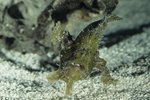Things You'll Need
Brood stock pond or aquarium
Male and female pacu
Syringe and soft canule pipe
Petri dishes
Assistant
Pipette
Small glass bottles
Zooplankton
60-gallon fry aquarium
The red belly pacu is native to rivers in South America. These large vegetarian fish are not typically spawned in captivity, due to their adult size of 30 inches. Pacus have been induced to spawn in research facilities, with the use of hormones. Adult male pacus are identified by their pointed back and anal fins. The red color on the abdomen of the red belly pacu is also more intense in male fish.
Stop feeding the breeding fish a day or two prior to inducing spawning, via pituitary extract injection.
Inject the female pacu with carp pituitary extract at the dose of a half teaspoon per every 2.2 pounds of fish weight. Inject into the heavy muscle mass on the shoulder area of the fish. Pituitary extract can be obtained from an aquatic research facility.
Inject a second dose of pituitary extract into the same female, between four and a half and five hours after the initial dose. Inject a dose of two and a half teaspoons per every 2.2 pounds at this time.
Inject the male immediately after you have given the female fish her second injection. Inject the male fish with a dose of a half teaspoon per every 2.2 pounds.
Observe the female pacu from above, five to six hours after the second injection. A gravid female will visibly show that she is heavy with eggs.
Remove the gravid female from the water and place her on a wet towel. Request an assistant to hold the fish if required. The assistant should wet his hands prior to restraining the fish.
Insert the soft canule tube that is attached to a syringe into the vent of the pacu and pull very gently on the syringe plunger, to remove eggs from the fish.
Place these eggs into a Petri dish and add dechlorinated water to the dish. This amount need not be more than one third the volume of the egg mass in the dish.
Remove the male fish and lay him onto a wet towel. Request an assistant to hold the fish if required. The assistant should wet his hands prior to restraining the fish. Gently squeeze the abdomen of the fish, but apply sufficient pressure to strip sperm from the vent.
Place a Petri dish against the fish’s body to catch the sperm or milt.
Draw up the milt with a clean pipette.
Squeeze up to 10 drops of milt over every 150 cc of egg mass.
Use a clean feather to mix the milt and eggs.
Pour an additional small volume of water into the dish after 15 to 20 seconds and gently shake the dish once again.
Pour the fertilized eggs into small glass jars, filled with water from the adult fish’s tanks.
Observe hatching in approximately 48 hours.
Feed the hatchlings from the third day after hatching on zooplankton, which is available from an aquatic research facility.
Transfer the fry into rearing aquariums eight to ten days after hatching.
Introduce a powder fish food at this time. Feed three times daily, but only the amount that the fry can consume in 10 to 15 minutes.
References
Writer Bio
Virtually growing up in a computer repair shop, Naomi Bolton has held a passion for as long as she can remember. After earning a diploma through a four year course in graphic design from Cibap College, Bolton launched her own photography business. Her work has been featured on Blinklist, Gameramble and many others.




